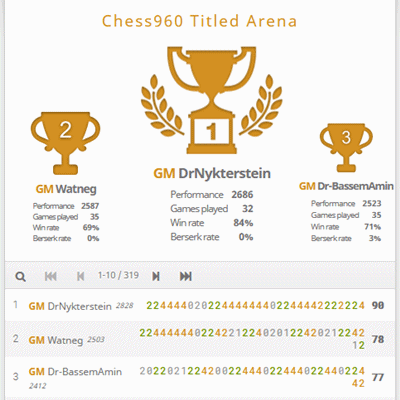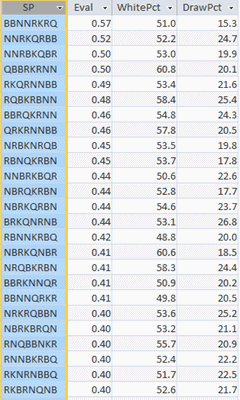Due to the recent gain in popularity of the Chess960 (or Fischer Random) variant, we're hosting a bonus Titled Arena: Chess960 Edition! The Titled Arena has become among the world's strongest Bullet tournaments, and we're proud to now also offer a high quality Chess960 tournament to our players.
Many of you have also requested a longer time control during these titled events, so we're trying 2 minutes + 1 second increment this time. Moreover, to ensure that each player will get enough games with this longer time control, we're increasing the tournament duration from the usual 2 hours to 3!
The tournament Chess960 Titled Arena #960feb19 (ditto) finished just in time to make the deadline for this week's post. Here is a copy of the winners' podium.

For future reference, I also noted the links to the three winners' Lichess pages:-
- 1st: DrNykterstein
- 2nd: Watneg
- 3rd: Dr-BassemAmin
'DrNykterstein' is better known as World Champion Magnus Carlsen. His Lichess page eventually leads to a list of all games he played during the event. Last year he won an unofficial Chess960 World Championship, which I reported on this blog in 2018 Carlsen - Nakamura (February 2018).
Second place Watneg is an anonymous GM, while third place went to Egyptian GM Bassem Amin. The game between Carlsen and Watneg can be found at GM DrNykterstein vs GM Watneg: Analysis board (lichess.org). To document the progress of the tournament, here are a number of tweets I picked off the Lichess Twitter page:-
- The Chess960 Titled Arena just started! Plenty of titled players are streaming the event; find links to the streams on the tournament page.
- 36 minutes to go and DrNykterstein is in 1st place for the first time in the tournament. Watch ChessNetwork's stream.
- 18 minutes left of the tournament and leader DrNykterstein (MagnusCarlsen) is playing the anonymous GM Watneg, who is in 2nd place!
- The Titled Arena has never been this close before! Only 2 points from 2nd to 6th place! Congrats to Magnus Carlsen for winning the first Chess960 Titled Arena!
- We'll also include this information from the Titled Arena announcement blog post since we have gotten some questions about it. • Tiebreak.
- DrNykterstein on top of the Chess960 leaderboard on @lichess with 235 rating points clear of second!
- 2649 games were played in the Chess960 Titled Arena... • The tournament page says 2674 games played.
- Q: After how many ply in a chess960 game is it indistinguishable form a standard game? To try to answer, I used 20,000 games from the @lichess database and a neural network to do classification.
- Knowingly beating the world champion! • twitter.com/IM_Rosen
Who said chess960 levels the playing field between experienced chess players?

